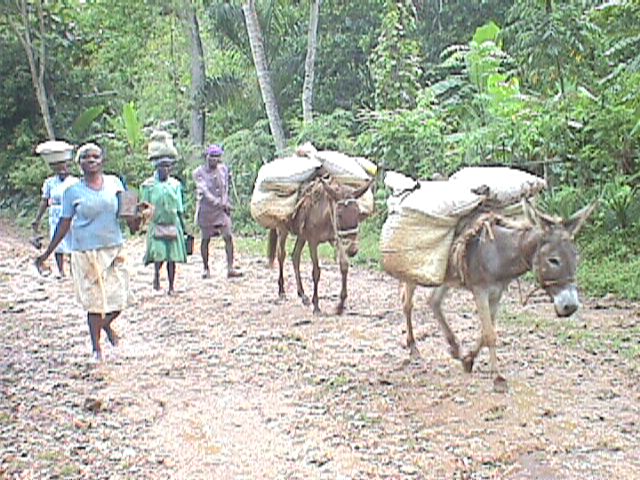Named for a migratory bird that assiduously searches for and finds food wherever it goes, the Haitian madam sara (pronounced ma-dan sé-ra) acts as the critical market link between rural producers and the urban consumer, most importantly the 30% of the national population who live in Port-au-Prince, many of whom work for wages and receive remittances from overseas migrants.
There are several characteristics of the madam sara that outsiders and urban based Haitians commonly misunderstand. Hence I’ve summarized the list of characteristics below, culled from focus groups and key informant interviews over the past three decades.
- Madam sara are predominantly rural woman who, in normal non-crisis times, purchase produce in rural areas, typically near to where they live; then transport the goods directly to larger rural, regional, or urban markets, with Port-au-Prince being the most prized and lucrative market
- Madam sara seldom venture into unfamiliar territory; rather they overwhelmingly operate either in their native rural area or an area with which they are familiar and have kinship relations
- Although the most heavily capitalized and visible madam sara use public truck transportation, many move their cargo on foot, donkey or mule [i]
- By virtue of the fact that they focus on rural produce, most madam sara specialize in whatever commodities are seasonally available in their activity zone
- Perhaps the most common misunderstanding and something so consistent that it could be elevated to the status of a rule, madam sara return to the rural areas with either no merchandise, or with other local produce that is unavailable where they live (seasonal produce or produce from a different agro-ecological region). They do not, as many people assume, trade in imported goods except in the rare periods where there is no local produce to be had at all. And the reason is because the most lucrative market for the madam sara is local produce. In part this is because cash is scarcer in rural areas–where they would have to wait a long time to recuperate their investment. In contrast, they can sell all their produce in a couple days in the cash-flush urban market and then return to the rural areas to repeat the cycle. For example, the profits for a madam sara going from Segen to Port-au-Prince is 100% for a one day walk and one to two days of selling; if she goes in the other direction, to Kay Jacmel, it is 50% with same day sales; if on the other hand, she buys a sack of rice, her profit is 20%–one fifth that of the madam sara destined for Port-au-Prince– and her average turnover rate is 15 days—five to seven times as long as the madam sara destined for Port-au-Prince)
- Madam sara seldom take standard loans because it cuts too heavily into their own earnings
- Madam sara often get produce on credit from farmers or especially from fisherman
- Madam sara are often related through kinship to producers, particularly in the case of fisherman
- Madam sara often give credit to fixed and trusted clients (kliyan) with whom they have a long-term trade relationship and most of whom fall into the category of marchann chita,–sitting merchants–or machann kinkay– literally “merchants of lots of things”–women who typically have little capital or operate on credit from the madam sara,
- When in Port-au-Prince the more capitalized madam sara sleep in depòt (storage facilities) with their merchandise–which they are loath to leave unguarded–and they stay there until they have sold their goods or until their kliyan, to whom they have given credit, have returned with the money (typically 2 to 3 days); the less capitalized sara often sleep in the market stalls,
- In broad terms, there are no urban madam sara. Those men and women who purchase imported produce and redistribute it inside or outside of the principal cities are known as komèsan (distributors) who own storage facilities in the city or provincial towns and hamlets; or they fall into another category of machann chita, those who sell out of their home, a boutik (store), or a fixed place along the roadside or in the market.
- While the madam sara is the principal accumulator, mover, and distributor of domestic produce in Haiti, and as such represents the most critical component in what anthropologists have long called the internal Haitian marketing system, her opposite and what can be conceptualized as her figurative nemesis, is the komèsan (distributor), the handler of durable imported staples mentioned above. The komèsan is the key figure representing the incursion of the global market economy and foreign produce into Haiti, a link in what can be analytically categorized as a market chain separate from the madam sara and Haiti’s Internal Rotating Market System, one that moves in the opposite direction, both literally, in terms of the primary flow being urban to rural (in contrast to rural to urban), and figuratively, in terms of its opposition and undermining of domestic production. (go here for a discussion of the madam sara vs. the komèsan).








